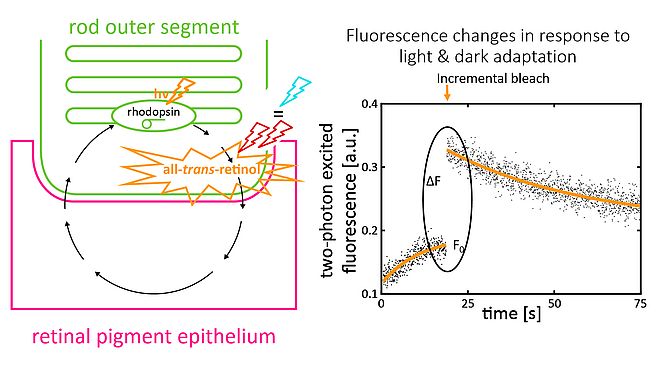You are here: vision-research.eu » Vision Research » Vision in the European Focus » 2019 » Prestigious ERC Starting grant goes to Christina Schwarz
Prestigious ERC Starting grant goes to Christina Schwarz

A prestigious ERC Starting grant goes to Christina Schwarz, PhD to explore Visual Processes with Two-Photon Ophthalmoscopy
Out of 867 submitted ERC Starting Grant proposals in the Life Sciences 115 were granted. Dr. Schwarz will take the opportunity to perform her innovative work at the Institute for Ophthalmic Research in Tuebingen, Germany. The development of an advanced optical instrument will allow her to study the retina in the living human eye.
Within the project TrackCycle.2P physicist Christina Schwarz wants to develop a method to investigate the first steps of light perception in the retina for use in humans. In the long term, the method is intended to serve for early diagnosis of retinal diseases.
Many retinal diseases that lead to blindness, such as age-related macular degeneration or the genetic disease retinitis pigmentosa, can only be detected at a late stage or with genetic testing. So far, there are hardly any imaging methods for early objective diagnosis. Pathological changes in the retina affect the visual cycle that is initiated at the visual pigment in the photoreceptors of the retina: the visual pigment captures photons of light and subsequently changes to an excited state. This triggers the conversion of the light energy into an electrical impulse, which is transmitted to the brain via the optic nerve and produces the actual visual impression. The visual pigment is then regenerated and can absorb photons again.
It is this process that Dr. Schwarz intends to study with two-photon ophthalmoscopy, a highly accurate non-invasive method for examining the fundus of the eye. She will further develop the measurement method that has already been tested on animals and translate the technique to human. Ultra-short laser pulses are used to cast light onto the retina and measure the visual cycle with a special ophthalmoscope. This is done by taking advantage of the fact that during the course of the visual cycle a molecule is produced, which can be excited to fluoresce.
A major goal of this project is to measure the strength of the fluorescent light in both types of photoreceptors in the retina, the rods and cones, in subjects with healthy eyes in order to learn more about the kinetics of the visual cycles in the normal range. The measurements should enable the detection of attenuations or slowdowns of the visual cycle in the event of a pathological change in the retina. Moreover, the visual experience in people exposed to two-photon ophthalmoscopy will be investigated. This will allow a better insight into the first steps of vision.
About Dr. Christina Schwarz
Christina Schwarz studied physics and medical physics at the University of Heidelberg with a focus on biomedical optics. After completing her PhD at the University of Murcia in Spain, she moved on to the University of Rochester in New York, USA where she was a postdoctoral researcher for several years. The ERC-project funded with 1.85 m € over the next 5 years will give her the opportunity to establish her lab at the University of Tuebingen.
ERC Starting Grants
408 early-career researchers have been awarded European Research Council grants in this year’s first completed ERC call for proposals. The highly-coveted funding will help individual scientists and scholars to build their own teams and conduct pioneering research across all disciplines. The grants, worth in total €621 million, are part of the EU’s Research and Innovation programme, Horizon 2020.
Carlos Moedas, European Commissioner for Research, Science and Innovation, said: “To answer the most difficult challenges of our age, researchers need the freedom and conditions to follow their curiosity. This is what the EU provides via the European Research Council grants: an opportunity for outstanding scientists to pursue their most daring ideas.”
President of the European Research Council (ERC), Professor Jean-Pierre Bourguignon, commented: “Science breaks down borders. With researchers of 51 nationalities, the outcome of this call marks a record high in ERC competitions. It also reminds us that talent is everywhere to be found and it is essential that the EU keeps attracting and funding outstanding researchers from all over the world. It is with great pride that the ERC contributes to this challenge.”



